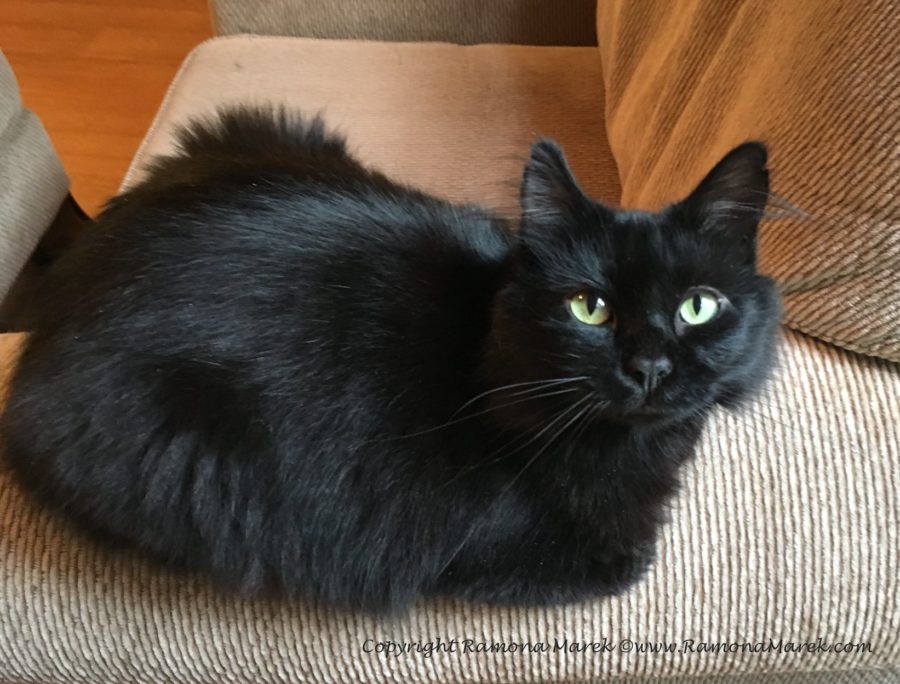My mother is a Cat Lady in training. Because she has severe allergies and asthma, the last and only cat she lived with in my lifetime was nine lives ago way back when I was in high school. That changed three years ago when my sister rescued a tiny, tailless, longhaired black kitten who was malnourished and had broken and missing teeth. Mom and Blue have developed a routine and bonded in the comfort of a favorite chair. Learning to live with her new feline housemate, Mom often asks “why do cats…” questions. One of her questions after closely observing Blue as she sat on the chair arm was, “Why do cats have vertical pupils?” Good question, Mom.
Recently a group of scientists were also curious about the significance of pupil shapes in terrestrial species. Pupils come in a variety of different shapes, but why? In their analysis of 214 land animals, the scientists looked at the animal’s lifestyle (foraging mode, active in the day, night, or both), eye placement on the head, and three pupil shapes–round, horizontal, and vertical. Martin Banks, a University of California at Berkeley professor of optometry, and co-author Gordon Love, a professor of physics at Durham University, found a striking correlation between pupil shape and ecological niche in the animal kingdom; that is, their foraging mode and time of the day they are active.
Lifestyle Adaptation
Round pupils were linked to “active foragers,” taller animals such as wolves, lions, and tigers, that chase down their prey. Animals with horizontally elongated pupils tended to be plant-eating prey species with eyes located on the sides of their head; for instance, deer, sheep, and horses. This shape and placement gives these animals a panoramic view so they can scan for danger in all directions while grazing.
And vertical-slit pupils? Animals with vertically elongated pupils were likely to be ambush predators, animals who lie in wait to kill their prey, who hunt during the day and night and, like most predators, have forward-facing eyes. Such animals include foxes, some reptiles and, yes, domestic cats. The researchers noted that these predators need to accurately judge the distance to pounce on their prey. The vertical slit has optical features that make it ideal for that.
Stealth Mode
Like the aperture in a camera, the pupil’s function is to regulate the amount of light that enters the eye by constricting (closing) or dilating (opening) the pupil. Constricting circular pupils, like humans have, use ring-shaped muscles but vertical-slit pupils have two extra side muscles that more strongly open or close the pupil, allowing a larger change of area. The vertical slits in cats undergo a 135-fold change in area between constricted and dilated states while humans have only about a 15-fold change. Researchers say this ability gives cats the dynamic range to help them see in dim light without being blinded by bright sunlight.
After regulating the pupil to the right opening for the environmental light, ambush predators must accurately gauge the depth to efficiently pounce on their prey. The stealthy vertical slit is the perfect adaptation, with two ways to gauge depth without moving: stereopsis and blur. Stereopsis, or depth perception, is where the brain perceives information from slightly different angles from the left eye and right eye to estimate distance. To test stereopsis on yourself, hold your finger out in front of your eyes. Close your right eye then your left eye. That shift in distance you see is stereopsis. The second method is blur, in which objects at different distances are out of focus.
Stereopsis works best when shapes and contours are vertical and at a distance. Narrow vertical pupils give the sharpest image in this instance. Blur functions best for horizontal contours and close-in targets. Wide-open pupils are best in this method. The optimal shape to use both methods is vertical-slit pupils, which are narrow horizontally and wide vertically–which just happens to be the exact shape of cat pupils.
The scientists were surprised to discover that predators with slit pupils were small and close to the ground. Among the 65 frontal-eyed ambush predators in this study, 44 had vertical pupils, and 36 had shoulder heights that were less than 42 centimeters (16.5 inches). Vertical pupils appear to maximize the ability of small animals to judge distances of prey. This is why domestic cats have vertical-slit pupils and their larger brethren, lions and tigers, have round pupils.
Your cat’s vertical-slit pupils do more than regulate light and provide stealthy predator calculations; they also function as an emotional barometer of your cat’s mood. Read more about cat body language and eyes here.
This article was reviewed/edited by board-certified veterinary behaviorist Dr. Kenneth Martin and/or veterinary technician specialist in behavior Debbie Martin, LVT.
Ramona D. Marek, MS Ed, is an award-winning writer and 2017 recipient of the prestigious Fear Free Pets Award. She writes about pet care, health and behavior, and cats in the arts. She’s also the author of “Cats for the GENIUS.” Her feline muses are Tsarevich Ivan, a joie de vivre silver tabby Siberian, and Natasha Fatale, a full-time diva dressed as an “anything but plain” brown tabby. You can read more about Ramona and her work at www.RamonaMarek.com.








